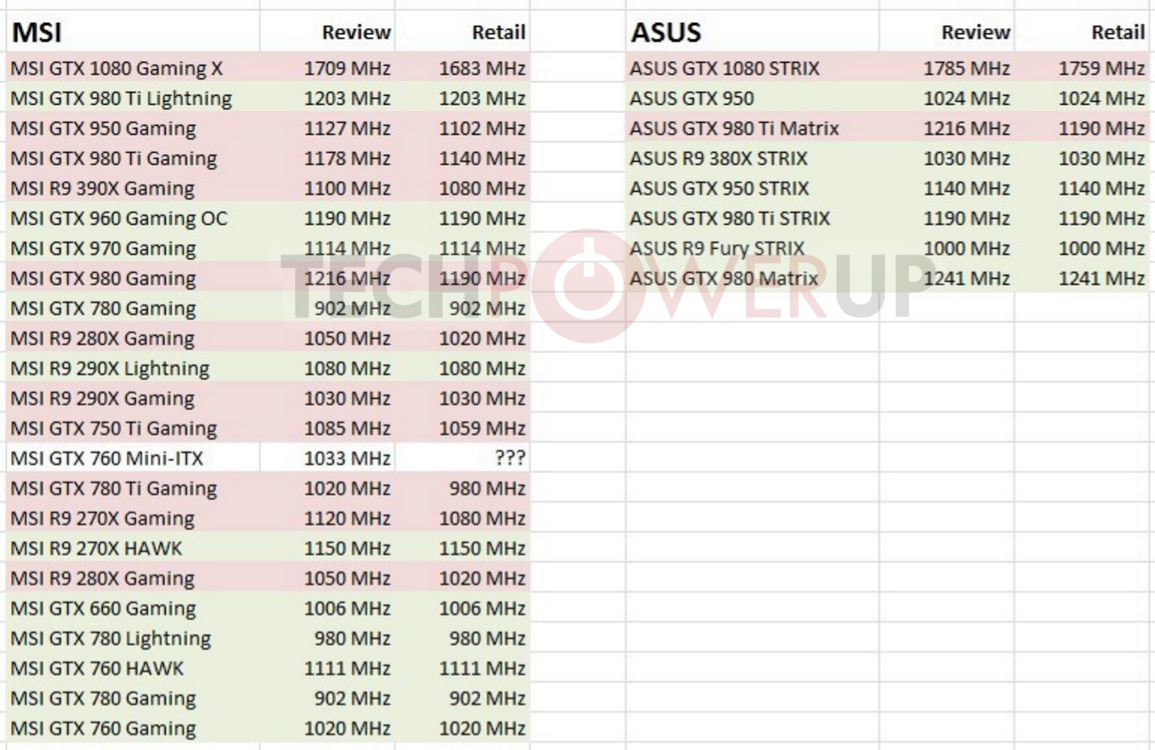MSI and ASUS accuse of sending out "overclocked" video cards for reviews

Most technology companies have a practice of sending new products to bloggers, techno-media, video bloggers. The latter are studying new items and publish reviews of such devices. Reviews, by the way, are far from always positive. Many companies, including MSI and ASUS, send their new products. The other day, one and the other company was accused of sending in advance “overclocked” to the review using special software of video cards.
According to the journalists of the Techpowerup portal, when studying the operating mode of the GTX 1080 card (manufactured by MSI), it became clear that it was already in peak performance mode. This card has only three modes of operation: Gaming Mode, Overclocker Mode and Silent Mode. When a card and drivers are installed to it by a regular user, Gaming Mode is activated. In order to get Overclocker Mode, you need to use a special utility. Some gamers use such a utility, some do not. Sending a video card for review, the manufacturer decided to immediately activate Overcklocker Mode.

')
This mode does not give a huge performance boost. For example, in the normal gaming mode, the card works with the following characteristics - 1683 MHz and 1822 MHz GPU. In Overclocker Mode, it works with slightly improved performance — a 1708 MHz and 1847 MHz GPU. The gain is a little more than 1%. It seems to be a bit. But in the modern world of technology, even a minimal advantage is enough for the buyer to opt for a slightly faster product.
When checking, it turned out that ASUS uses the same tactics. So the video cards received by the reviewers of the mentioned site are not 100% the product that is supplied to regular customers.

Screenshot of the CPU-Z program, showing the difference between the retailer and the "overview" version of the video card
After the site journalists found this slight difference, they decided to check out the previous cards sent by MSI and ASUS. As it turned out, MSI has been practicing card overclocking before being sent to surveyors for several years. ASUS began to use a similar trick quite recently, probably because “once a competitor does this, we can”.

Judging by the screenshot, not all cards are accelerated digitally, but is it a coincidence or intentional actions by the manufacturer? The Techpowerup don't know that. However, resource representatives assume that map developers overclock them before sending to surveyors for the reason that the latter usually do not install additional software. And that is why video card manufacturers want IT journalists to work immediately with the maximum performance mode.
What do ASUS and MSI say?
Both companies have already managed to give an official response to the publication of Techpowerup. The statement of ASUSTeK Computer fully confirms the assumption of reviewers of the resource mentioned above. The company says that the overclocking of cards in the so-called ROG Strix GeForce GTX 1080 and GeForce GTX 1070 press samples was performed so that the cards were tested at maximum performance.
MSI said the following: “Our press and retail samples are hardware identical, demonstrating the same performance. Also, both types of cards work with the same profiles in the MSI Gaming App. Data on performance profiles is open to all, and is indicated on our product pages. Retail cards work in gaming mode, which provides the best performance / power ratio ...
In order to use the maximum performance and all the features of MSI GAMING products, we suggest using the free MSI Gaming App. This program allows you to activate profiles with just one click, while the profile is activated with a given level of performance.
As observers have already noticed, software such as the MSI Gaming App is rarely used in the preparation of reviews. That is why our MSI GeForce GTX 1080 and GTX 1070 GAMING X video card samples work at maximum performance. ”
Source: https://habr.com/ru/post/395521/
All Articles